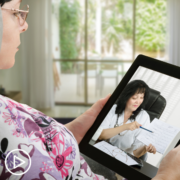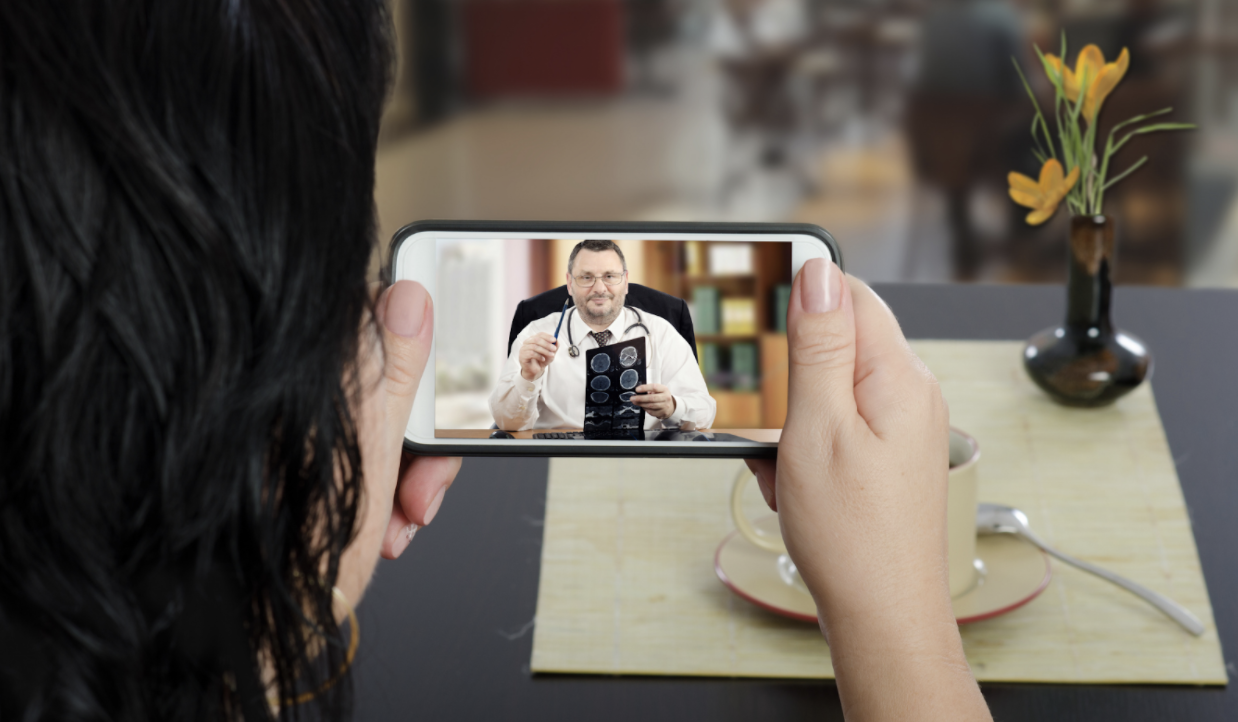Tag Archive for: Myeloma TelemEDucation
Telemedicine Visit Preparation Tips From Myeloma Patients to Myeloma Patients
Telemedicine Visit Preparation Tips From Myeloma Patients to Myeloma Patients from Patient Empowerment Network on Vimeo.
With the pandemic altering our conventional communication methods, how can myeloma patients be prepared for upcoming telehealth appointments? Myeloma patients Barry Marcus and Honora Miller share their top tips for being as prepared as possible for a telemedicine visit.
See More From the Myeloma TelemEDucation Resource Center
Transcript:
Barry Marcus:
One of the virtues of it is that you can seek opinions from a wide geographic area, you don’t have to travel, some opinions that you might want to get could be thousands of miles away, and I didn’t feel when I had a telemedicine visit that was really much different than an in-person visit, we talked about the same things we would have had we been face-to-face, and I was very happy with it.
Honora Miller:
I’ve had quite a few telemedicine visits since the beginning of COVID, almost the entirety of my myeloma specialist visits have been via telemedicine. And I don’t have to drive an hour and a half to get there. My doctor is on time. We have the same conversation we would have had in person, and it’s very efficient, I come with my list, and it’s very efficient. I do see my local oncologist via in-person every other month so that they can lay their hands on me, and that seems to be sufficient, but every other month, just before my infusion, I’ll have a telemedicine visit with the oncologist and that’ll be sufficient and it’s cut down on a lot of anxiety around COVID.
Barry Marcus:
I would definitely recommend having, as you mentioned, a list of questions before you initiate the meeting, and think about what you really want to get from the meeting, and then review your list maybe towards the end and make sure that you have gone over the things that you wanted to talk about.
Honora Miller:
Agreed, I feel that it helps focus the conversation, and then you just know you’ve covered everything that’s concerned to you.
Will Telemedicine Be a Mainstay for Myeloma Patients After the Pandemic?
The Patient Empowerment Network (PEN) is fostering change toward achieving equitable healthcare for all. One resource, the Myeloma TelemEDucation Empowerment Resource Center is to significantly improve multiple myeloma patients’ and caregivers’ familiarity with remote access to healthcare, and thus increase quality of care regardless of geographical location. This one-of-a-kind resource center is intended to educate the myeloma community on the practical usage of telemedicine tools, to humanize patient and provider experiences.
Here’s a summary view of the knowledge gained about telemedicine to help provide optimal care to myeloma patients and to aid in receiving optimal care no matter virus limitations, where patients live, and other factors.
Benefits and Limitations of Telemedicine Visits
There are both benefits and limitations of telemedicine visits. Some benefits of telehealth include:
- Telemedicine allows care providers the opportunity to determine when myeloma patients really need to be seen in-person.
- Standard of care and maintenance treatment are usually a good fit for using some telemedicine visits in clinical trials.
- The option to get laboratory work done closer to home is a benefit for saving travel time and from taking time off of work and also lessens patient exposure to viruses.
- Telehealth allows care providers the opportunity to meet family members of some patients who can’t make it to in-person visits and to get to know their patients on a more personal level.
- Care providers are now able to provide second opinions to patients in other parts of their state and even to some patients across the country.
Unfortunately, some limitations of telehealth include:
- Gauging toxicity and other things with new treatments are usually best done along with performing a physical exam.
- Some patients only have technology access to talk over the phone and don’t have access to use video due to their device or due to lack of Wi-Fi bandwidth.
- Physical examinations cannot be performed via telehealth visits.
- Some providers feel it’s more difficult to establish a bond with some patients and to have considerable discussions with then over telemedicine.
- Open and honest communication between patients and care providers is sometimes better served in-person.
How to Optimize a Telemedicine Visit
Just like in-person care visits, telemedicine visits are scheduled with a time limit in mind. Some things to remember about telemedicine visits are:
- Try to write down your questions for your doctor or care provider before your appointment to keep on track. Keep it next to you for easy access during your visit.
- If patients normally have a friend or loved one join or doctors have a nurse or pharmacist join for in-person visits, have them join your telemedicine visits to help take notes, to ask questions, and/or to provide answers or additional information.
- If a video conferencing tool is needed for your visit, install the tool on your laptop, tablet, or smartphone ahead of time to prevent rushing before your appointment. If possible, try to test the video conferencing tool with a friend or loved one a day or so ahead of your appointment.
- If there’s anything you don’t understand during the appointment, ask your doctor to explain it again – whether it’s medication instructions, test results, a new medical term, or anything else.
- If you feel like a treatment isn’t working well for you, ask your doctor about possible medication or dosage changes.
- Just like in-person doctor visits, your doctor or care provider may run a few minutes late. Try your best to remain flexible and to be patient.
Telemedicine and Multiple Myeloma Clinical Trials
To the surprise of some, telemedicine has taken a role in multiple myeloma clinical trials. Currently, and looking to the future, patients can expect:
- Telemedicine to continue as an option for follow-up visits along with in-person visits in clinical trials.
- Paperwork for clinical trials to be available to complete online for an easier process for joining clinical trials.
- Multiple myeloma clinical trials to provide optimal care through the use of both telemedicine and in-person visits.
- Telemedicine to provide more options for clinical trial access for those who live in remote areas.
- Multiple myeloma clinical trials for quality-of-life studies, engagement studies, educational studies, and possibly others to be available via telemedicine.
Financial Benefits of Telemedicine
Telemedicine has brought some financial benefits for multiple myeloma patients, including:
- Telemedicine saves the time and costs of traveling to appointments and can reduce or sometimes eliminate the need to take time off from work for an appointment.
- The option of connecting with your doctor via telemedicine can sometimes eliminate the need for costly urgent care visits.
- The use of telemedicine eliminates the need to find child care for patients and care partners with young children who couldn’t take them along to in-person doctor appointments.
Telemedicine Glossary
Here are some helpful telemedicine terms to know:
- HIPAA – HIPAA, or the Health Information Portability and Accountability Act, is a healthcare compliance law providing data security and privacy for the safeguarding of patient medical information. In telemedicine, provider-patient communication must take place through HIPAA-compliant secure platforms.
- Patient portal – a secure Internet sign-on that allows patients to contact their provider, review medical tests and records, access health education materials, and seek appointments. Most provider networks develop a patient portal before they move to full video appointments.
- Remote monitoring – type of ambulatory healthcare where patients use mobile medical devices to perform a routine test and send the test data to a healthcare professional in real-time.
- VPN – a VPN, or virtual private network, is a secure and private way to connect to the Internet over public wireless connections. VPNs are particularly important for those living the digital nomad lifestyle and connecting in foreign countries where networks may be more vulnerable to communication transmission interference.
Now that telemedicine tools continue to increase in use and to be refined, multiple myeloma patients can feel hopeful about improved care and treatment ahead for patients. As a step in that direction, take advantage of the resources below and continue to visit the Myeloma TelemEDucation Empowerment Resource Center for informative content about multiple myeloma and telemedicine.
Resources for Telemedicine and Multiple Myeloma
Are There Limitations of Telemedicine for Multiple Myeloma Patients?
How Will the Pandemic Impact Multiple Myeloma Trials?
Is Telemedicine Here to Stay for Multiple Myeloma Care?
What Are the Benefits of Telemedicine for Myeloma Patients?
How to Make the Most of a Virtual Visit
Telemedicine & Second Opinion Options
What Are Best Practices for Multiple Myeloma Patients Utilizing Telemedicine?
How Can Myeloma Patients Reduce Infection Risks During Medical Appointments?
Financial Resources for Patients and Families
Will Telemedicine Mitigate Financial Toxicity for Myeloma Patients?
Will Telemedicine Be a Long-Term Survival Tool for Myeloma Patients?
Are There Limitations of Telemedicine for Multiple Myeloma Patients?
Are There Limitations of Telemedicine for Multiple Myeloma Patients from Patient Empowerment Network on Vimeo.
What have some multiple myeloma patients seen in terms of limitations of telemedicine? Myeloma expert Dr. Sarah Holstein details some obstacles some of her patients have gone through – and share some benefits that she’s experienced with her patients.
See More From the Myeloma TelemEDucation Empowerment Resource Center
Related Resources:

How Can Myeloma Patients Reduce Infection Risks During Medical Appointments? |

|

Will Telemedicine Mitigate Financial Toxicity for Myeloma Patients? |
Transcript:
Dr. Sarah Holstein
So, I’ve actually found that there’s very few limitations. One of course is access to the appropriate technology to be able to do telemedicine, so there are a few patients that I really just need to do telephone visits with, and I think those are a little bit more difficult there’s just something about being able to see somebody on the screen that you kind of get an immediate sense for how they’re doing, and that’s a bit lost when it’s just via telephone. So, for those patients who either because of not having fast enough Wi-Fi service based on where they live, or just not having the access to the technology, video cameras, phones with videos in them, that can be a restriction.
But otherwise, I think this has been a really good thing for my patients, and it’s given me a glimpse into their home life, I can’t tell you how many times I’ve had dogs or cats wander into the telehealth appointment, and usually we stop to talk about those dogs or cats, and it’s just a way to really get to know my patients a little bit better, it’s allowed me to see more family members because many times, not all the family members would be able to come for an in-person visit, but now they’re at home and so it’s given me more insight into how my patients live.
Will Telemedicine Mitigate Financial Toxicity for Myeloma Patients?
Will Telemedicine Mitigate Financial Toxicity for Myeloma Patients? from Patient Empowerment Network on Vimeo.
With the entry of telemedicine into the multiple myeloma care toolkit, there are some real benefits to the cost of care visits. Dr. Sarah Holstein outlines some of the financial benefits that she’s seen for her patients – and how the logistics of scheduling appointments has changed.
See More From the Myeloma TelemEDucation Empowerment Resource Center
Related Resources:

Will Telemedicine Be a Long-Term Survival Tool for Myeloma Patients? |

|

|
Transcript:
Dr. Sarah Holstein
So, there’s definitely quite a bit of financial toxicity associated with being a patient who has myeloma. There of course is the cost of the drugs and treatments themselves, but there’s also the personal time cost. So, the cost that it takes to perhaps take a half day off of work or a full day of work to see your provider in person, and the flexibility that telemedicine allows, namely being able to do your appointment from either the privacy of your own home or in some cases the privacy of your own office or even your own car, really allows patients to keep going about their business without having to take all that time off to come travel. There’s the cost associated with gas mileage in some cases, costs associated with parking, although thankfully, that’s not a cost that’s occurred here at Nebraska Medicine. But I certainly know that that can be an issue at other institutions and can really add up for patients over time. So, it’s really been so much easier for patients to get in to see me even when my schedule is fairly full, because they don’t have to think about, “Well, I don’t need to leave work an hour, try to go over my lunch break,” or something like that, they can just schedule it and do it from their office.
I think it’s been a good thing for patients and hopefully is cutting down costs for them.
How Can Myeloma Patients Reduce Infection Risks During Medical Appointments?
How Can Myeloma Patients Reduce Infection Risks During medical appointments from Patient Empowerment Network on Vimeo.
How much of a risk are medical appointments for multiple myeloma patients? Myeloma expert Dr. Sarah Holstein explains infection risks of infusion appointments versus clinic visits – and shares how she’s helped to ensure safe visits for her patients.
See More From the Myeloma TelemEDucation Empowerment Resource Center
Related Resources:

|

Will Telemedicine Mitigate Financial Toxicity for Myeloma Patients? |

|
Transcript:
Dr. Sarah Holstein
So, I think the risk associated with going in to get your blood drawn is probably quite low. All health care providers are going to be masked. The time that is spent getting the blood actually drawn is quite low and generally are in and out. So, for what I’ve tried to do for patients is of course to minimize unnecessary lab draws and if possible, try to coordinate them with other tests that are being done that day or other visits that are being done that day, and the infusion appointments, of course are necessary. But again, I think the risk of going to an infusion appointment is quite low, where I think the risk gets a little bit higher is when you’re sitting in waiting rooms of clinics and some people are slipping their masks off to drink coffee or to do other things, like that. And so, on my end, what I’ve tried to do to reduce risk is to utilize telehealth appointments as much as possible so that patients aren’t spending time in waiting rooms, but again, some of the necessary evils are just that you have to get some labs drawn to make sure that it’s safe to administer chemotherapy to make sure that the treatment is working, and you also have to go to infusion appointments.
I will say I’m pretty strict about masking, so if I have a patient perhaps come in for an in-person visit and it’s the type of mask where it’s slipping off of their face as they’re talking, and we’ve all experienced those types of masks that fit fine until you actually start talking. I’ll get a replacement mask for them to really make sure that everybody, the healthcare providers, the team as well as the patient, and if there’s a family member with them or a safest can be, and that includes wearing a properly-fitting mask.
How Will the Pandemic Impact Multiple Myeloma Trials?
How Will the Pandemic Impact Multiple Myeloma Trials? from Patient Empowerment Network on Vimeo.
How has the COVID-19 pandemic changed multiple myeloma clinical trials, and how can telemedicine play a role in trials? Dr. Sarah Holstein shares her perspective on how trials were altered and her suggestions for improvements in trials.
See More From the Myeloma TelemEDucation Empowerment Resource Center
Related Resources:

Will Telemedicine Be a Long-Term Survival Tool for Myeloma Patients? |

|

Are There Limitations of Telemedicine for Multiple Myeloma Patients? |
Transcript:
Dr. Sarah Holstein
Early on, I was very concerned about the ability to conduct clinical trials during the pandemic, early on, at least in our institution, and I know that there were many others across the country, there was a lot of concern about really limiting what was considered by the IRB (Institutional Review Board) to be an essential contact. They perhaps placed an emphasis on later phase clinical trials and thought that the earlier phase clinical trials weren’t necessarily proving to be a benefit for patients and therefore shouldn’t be opened, and I would have to say that that was not what my thought was. I really think that all clinical trials, whether it’s a Phase I, Phase II, or Phase III or of utmost importance to our patients and are important for their care. So again, early on, I was very concerned about limiting the access of clinical trials to patients. As the pandemic has continued and it’s become clear that this is going to be life as we know it for unfortunately, quite some time, I know at our institution, we’ve really tried to be as safe as possible, but all clinical trials are open and we’re allowed to enroll, I think there still is room for improvement with respect to how telemedicine is incorporated into clinical trials, and whether or not we can do things like allowing patients to get their study labs drawn closer to home as opposed to traveling to the academic center, so I think there continues to be room for improvement for really trying to minimize the amount of traveling that people do, and therefore the amount of potential exposure that patients have.
We still are not routinely using telemedicine for the clinical trial visits, that most of those are still in person. And I think depending on the specific trial, that is probably appropriate if you have a new agent and a lot of what you’re looking for is evidence of toxicity, I think it is important to be able to evaluate the patients in person and really be able to conduct a normal physical exam, having said that though, if a patient’s on a clinical trial where they’re receiving more standard of care, and perhaps it’s in a maintenance phase of a study, I think being able to utilize telehealth for some of those more routine visits would really be beneficial for both the patients and the healthcare team.
Is Telemedicine Here to Stay for Multiple Myeloma Care?
Is Telemedicine Here to Stay for Multiple Myeloma Care? from Patient Empowerment Network on Vimeo.
With the emergence of telemedicine for multiple myeloma care, it’s being looked at for long-term care. Myeloma expert Dr. Sarah Holstein shares her hopes for the future of telemedicine – and shares some tips for optimizing telehealth visits.
See More From the Myeloma TelemEDucation Empowerment Resource Center
Related Resources:

Will Telemedicine Be a Long-Term Survival Tool for Myeloma Patients? |

How Can Myeloma Patients Reduce Infection Risks During Medical Appointments? |

|
Transcript:
Dr. Sarah Holstein
I really hope telemedicine is here to stay. If you’re practicing in a place like I am, where patients come from quite a distance, it would be great in the future if some of the more routine visits, can be a telemedicine and perhaps get into a rotation or maybe every three or four months, they come and see me in person versus the rest of their monthly visits via telemedicine. So, I very much hope that the government, as well as insurance carriers will continue to provide coverage for telehealth visits in the future, because I think it’s really broadened access for patients and it’s been a really wonderful thing for them in general. In terms of tips for preparing, some of it just comes down to understanding the technology and getting familiar with what you need to click on and making sure that you’ve allowed your iPad or your phone or computer access to your camera, it sounds silly, but sometimes a big chunk of the appointment can be eaten away because of the settings being wrong or pop-ups, so some of it is just trying to figure out the system ahead of time before you log on.
But other than that, I would say, making sure that you understand from your health care team, whether or not you can forward the link, if you’re using Zoom, for example, to other family members, so that you
can have multiple family members kind of Zoom in at the same time to be able to listen, and that way you’re not relying on yourself to take notes, and everybody doesn’t have to be in the same place at the same time, which again, given the pandemic is not wise anyways. So, I think just trying to figure out the technology involved and then making sure that you can have access or provide access to your family members or friends who want to virtually come to your visit with you is key for a successful visit.
Will Telemedicine Be a Long-Term Survival Tool for Myeloma Patients?
Will Telemedicine Be a Long-Term Survival Tool for Myeloma Patients? from Patient Empowerment Network on Vimeo.
What can multiple myeloma patients expect for the use of telemedicine as part of their long-term care? Dr. Sarah Holstein shares her experience of using telemedicine for those with MGUS and those managing controlled disease – and her thoughts about the future of telemedicine.
See More From the Myeloma TelemEDucation Empowerment Resource Center
Related Resources:

Are There Limitations of Telemedicine for Multiple Myeloma Patients? |

How Can Myeloma Patients Reduce Infection Risks During Medical Appointments? |

|
Transcript:
Dr. Sarah Holstein
So, I think telemedicine is a really good fit for patients for either long-term survivorship issues or for patients that perhaps you’re just following with the precursor to myeloma, so for example, MGUS (monoclonal gammopathy of undetermined significance) where overall the risk is low that there’s actually going be a progression to myeloma over their lifetime.
So I have a number of patients who I see perhaps on an annual basis for those types of visits, and of course, over the last year, I’ve been doing a number of those visits via telehealth, and I think they’ve gone really well. It still allows me to ask my entire review of systems where I check through and make sure that there’s no subtle signs that I might be missing that somebody’s plasma cell disorder is progressing. They’ve had their blood work or scans or other testing done, and we can review those, but again, in those types of situations where the risk is low and somebody is doing well and it’s a fairly routine visit, I think the need to do a full physical exam, it’s pretty low, I think whether or not you’d hear anything on the lung exam in somebody who’s doing well and it’s just there for an annual basis exam, I don’t think that lung exam is going to add a whole lot, but really having the ability to still talk to each other, go over laboratory studies, really make sure that I’m not missing any subtle signs that might suggest concomitant lite amyloidosis or progression to myeloma can still very readily be done via telehealth.
What Are the Benefits of Telemedicine for Myeloma Patients?
What Are the Benefits of Telemedicine for Myeloma Patients? from Patient Empowerment Network on Vimeo.
How will myeloma patients benefit from telehealth visits? Myeloma expert Dr. Sarah Holstein shares benefits she has seen while caring for her myeloma patients including broadening access and the ease of seeking a second opinion.
See More From the Myeloma TelemEDucation Empowerment Resource Center
Related Resources:

|

Will Telemedicine Mitigate Financial Toxicity for Myeloma Patients? |

|
Transcript:
Dr. Sarah Holstein
So, I think telemedicine has been one of the few silver linings of this entire pandemic, I had personally never utilized telemedicine previously in my career, and now I’m using it almost extensively these days to care for my myeloma patients.
I’ve always had patients who tell me that they wish they didn’t have to take a half day off to come to a clinic appointment, and sometimes the clinic appointments are only 20 minutes, but they’re driving an hour and a half or two hours or more to come to those clinic appointments. So, some of it has just been the freedom that allows patients to go about their lives and not have to take time off of work or time off from other things that they’re doing to physically travel to come and see me. Telemedicine though, has also really broadened the access to me in my cancer center, again, based on where I’m at in Nebraska, patients would sometimes have to travel a very far distance to see me, and these days it’s just a matter of logging on via Zoom to access me, and it’s allowed me to see patients for second opinions in not only different parts in Nebraska that otherwise would have been difficult to reach, but also really across the country.
So, telemedicine in general, has allowed patients much more flexibility in seeing me and has also allowed the ability for me to do second opinions without making patients travel quite a distance.





